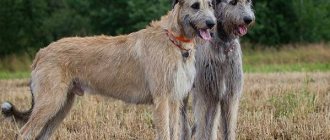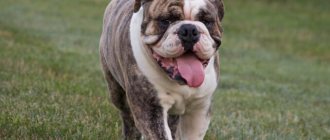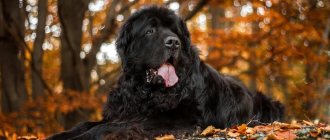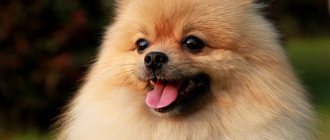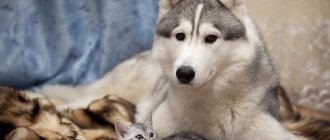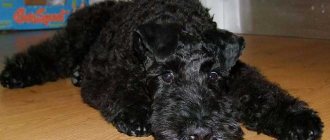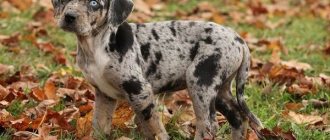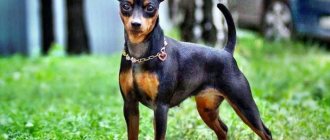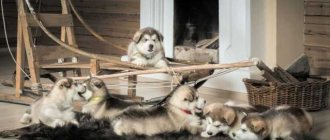Care and maintenance
The dog has long hair, so it needs daily grooming. But, they don't need a haircut. Those pets that participate in exhibitions or shows are bathed once every 7-10 days, while others do not need to be bathed as often.
To make it easier to comb your pet's silky locks, you need to fill a spray bottle with water and add a few drops of conditioner designed specifically for long-haired dogs.
First you need to spray the dog with this water, and then comb it well. By the way, this way you will protect it from severe tangling. Do not comb dry. This can seriously damage and break your pet’s fur, and make it even more tangled. The direction of the comb is strictly from roots to ends, and nothing else.
Also, to thoroughly comb the entire length, you can use special hair dryers that do not dry out the dog’s skin. In general, it is the animal’s fur that requires careful care, a lot of time and effort, and then the dog will look beautiful. A dog's long hair always gets into his food when he eats.
To avoid this, you need to use a special hair net that holds your hair and thanks to this it does not get dirty. Regular walking is very important for your pet. They must be long-lasting and active. It is advisable to spend them with fellow relatives so that the dog can run around for fun.
It is better and easier to keep such an animal in a private house, so that there is plenty of space and its own plot of land for active walks. In an apartment, the dog will get bored very quickly, will not be able to live a full life, will take up a lot of space and constantly demand from the owner to go outside.
It is better to own an Afghan Hound to people who have good experience in keeping and caring for dogs. Otherwise, for beginners, they will cause a lot of trouble and it will be a burden. Dog puppies should not be overexerted during childhood. Due to the heavy load, their legs - muscles and bones - may not form and develop properly.
And this will cause great discomfort in the pet’s future life. Experts recommend actively engaging in coursing with puppies. People who want to get an Afghan puppy need to remember a few important points:
- You shouldn’t tell your dog a categorical and stern NO;
- There should always be fresh cool water in the bowl;
- For a puppy, it takes some getting used to leaving dim lights in any room of the house. This is done for better adaptation of the furry one; later it can be turned off;
- they need to be praised for correct behavior;
- prevent the puppy from overheating and hypothermia;
- do not disturb your sleep. Puppies tend to sleep more than they play. This is due to their physical development; owners do not need to worry about this;
- necessary personal space and daily moderate running;
- Do not teach the dog to beg and eat from the table.
Afghan care
The key to a beautiful appearance, well-being and good health of an Afghan hound will be a proper and balanced diet containing a maximum high-energy protein component and a small amount of carbohydrates . It is permissible to feed your pet both natural home-cooked food and store-bought dry food for long-haired or hunting dogs of the holistic or super premium class:
- Skinner's Field & Trial;
- Brit Care Adult Large Breed;
- Wolfsblut Range Lamb Adult.
Brit Care Adult Large Breed - optimal calcium and phosphorus ratio, high glucosamine and chondroitin content support skeletal and cartilage health
The natural diet consists of:
- raw or boiled meat (beef, veal, rabbit, etc.);
- boiled offal (kidneys, hearts, liver, etc.);
- boiled sea fish without bones;
- cartilage and interior fat;
- boiled eggs;
- vegetables (fresh and boiled);
- fruits (pears, apples);
- porridge (buckwheat, rice, barley, etc.);
- low-fat fermented milk products (ryazhenka, cottage cheese, kefir, yogurt, etc.).
Vitamin and mineral complexes must be added to homemade food. Adults are fed twice a day, while puppies are given food up to 5-6 times (depending on age).
Fatty meats are strictly prohibited, especially pork, smoked, spicy, highly salted and spicy foods, legumes, as well as sweets and bakery confectionery products.
The most difficult thing to care for is the Afghan's long coat . The dog should be combed daily, using specialized conditioners for long-haired animals (Doctor VIC, Mr. Bruno “Obedient Silk”, etc.). A few drops of this product are dissolved in water, then the animal’s fur is moistened with the solution and only then combed. Bathe your pet once every 2-3 months with pet shampoo (8in1 Tea Tree oil Shampoo, Iv San Bernard Traditional Line Green Apple, etc.). Paws are washed after every trip outside.
It is best to take your Afghan Hound to dog grooming salons.
During meals, falling long hair is pinned up or hidden under a special net.
Video: Afghan coat care
Periodically examine the dog’s ears (weekly) and eyes (daily), cleaning them with a cotton swab dipped in veterinary lotion (Api-San “Rosinka”, “8 in 1”, etc.). Clean your teeth every 5-7 days with a brush and toothpaste that does not require rinsing. Growing claws are shortened approximately once a month, unless they wear down on their own during walks.
Afghan hounds can be kept in an apartment, as well as in a private house or country cottage. A lot depends on the character of the particular dog. For some, small square meters of enclosed space are enough, provided they take long and active walks every day (at least 1.5–2 hours). Others are only comfortable in a spacious enclosure or free-range. However, in this case, it is necessary to remember that Afghans jump well, and for them a fence up to 2.5 m high is not a restraining barrier.
Training
Afghan hounds are difficult to train due to their independent and stubborn nature . You need to start working with a puppy from the very first days of his appearance in the house, teaching him the simplest commands. At about 5–6 months they undergo a general obedience course (OCD), it is advisable to repeat it closer to three years.
It is best to entrust training to a professional who can handle difficult breeds.
Afghans should always be kept under control and should only be taken on a leash during walks.
Characteristics of the Afghan Hound breed
The Afghan Hound is a large hunting breed. It is also called - Baluchi Greyhound of Bamiyan, Afghan Tazy, Afghan Italian Greyhound, Bakhmul. Like any hunter, she has excellent vision, keen sense of smell and hearing. The Afghan Hound was first brought to the West at the end of the 19th century by English officers serving on the Indian-Afghan border. But the origin story is not exactly known. There is a legend according to which the Afghan was in Noah's ark among other rescued animals. In Afghanistan, she is considered an asset to the country and national pride. The Sinai Peninsula is considered the birthplace of baluchi.
In the 20th century, in the caves of Iran, scientists discovered ancient rock carvings of a greyhound, and thus a version of its ancient origin appeared. In Afghanistan, the Afghan hound is called Tazi, which means “fast running”. Perhaps the name comes from the city of Taiz in Yemen. Or it is connected with another city of Tazi, according to legend, the Sultan dedicated it to the dogs that saved his state from the Hindus.
Muslims are a people who have a negative attitude towards any dogs, calling them nothing more than a despicable creature. But the Afghan hound was able to take an honorable place in their history, showing excellent qualities as a hunter and shepherd, for which it was called “pure”. She tracked large game and kept it in place until the hunter arrived.
Care
Afghan hounds have a very long, thick and silky coat that requires careful daily grooming. Dogs with fur of this length are recommended to be washed with special conditioning shampoos at least once a month. After washing, the hair is carefully combed and then thoroughly dried with a hairdryer or naturally. It is allowed to use special dry shampoos in conditions where taking a full bath is not permissible. Such a dog needs to be brushed daily and very carefully. For these purposes, you should purchase a special hard metal comb and a brush made of natural bristles. After each combing, the hair should be well styled; it is allowed to weave small braids from the longest hair to prevent tangling.
In cold and dry seasons, the use of special antistatic agents may be required. Get your Afghan Hound used to brushing from puppyhood so that by the time the puppy grows up, regular brushing will become a habit. It is best to brush your puppy while standing or lying on its side.
Appearance of an Afghan Hound
The Afghani is a long-legged aristocratic beauty, her chic costume consists of a long satin cloak and flared trousers. A proudly raised head and royal posture attract the eye. All this creates a stunning overall impression - before you is the real queen of all dogs. To be completely captivated by the elegance of the Afghan, you need to watch it in motion. This cannot be seen in the photo of an Afghan hound. The coat flowing as you run will not leave anyone indifferent.
Torso
Always well built, slightly elongated, level back of medium length. The muscles are well developed, the lower back is straight, the croup is sloping at the bottom. The ribs are of the correct shape. Elegance is combined with strength.
Hind limbs
Stronger than the front ones, widely spaced, toes covered with long strands of hair. Hock joints with prominent angles.
Movement
Loose, soft, smooth, slightly springy. A characteristic feature is that the fur flutters beautifully in waves.
Wool
Very long, silky. The main part is guard hair; it partially covers the back, shoulders, and muzzle. The hairs on the muzzle are quite short, they gradually lengthen starting from the forehead. Other parts of the body are covered with soft hair, which is the undercoat.
Color
All types of Afghan Hound colors are allowed, except for variations with white spots on the head - this is a sign of non-compliance with the standard.
Size
The height of the Afghan hound is 63-74 cm, the weight of Afghan hounds reaches 20-30 kg. Males are slightly larger than females. At shows, judges look primarily at body type. The size of the Afghan hound in this case fades into the background if the dog looks harmonious.
Dog kennel Salam Esfahan. Afghan Hound
Take the Attention Test! Find 10 differences! (click right here!)
Find the answer Are you bothered by some problem or question? Enter “Breed” or “Name of the problem” into the form, press Enter and you will find out everything about the issue that interests you.
https://dog-care.ru/porody/pitomniki/sobak-afganskaya-borzaya-v-moskve.html
| Description: | The site is dedicated to the kennel 'Salam Isfahan', which breeds 2 breeds of greyhounds: Afghan and small English greyhound. As a result of many years of selection, our Afghans have a stable psyche, good health, and impeccable exterior. Titled producers of domestic breeding are used. |
| Contacts: |
History of the Afghan Hound breed
Greyhounds are one of the most recognizable and ancient breeds, and according to some markers in genetic tests, the Afghan hound differs very little from the wolf and is related to the ancient dog - the Saluki.
Modern purebred Afghans trace their ancestry to dogs brought to Great Britain from Afghanistan in the 1920s, and they were collected throughout the country and in nearby countries, where they served as hunting and guard dogs.
But what happened before that is a mystery, since there is no evidence that they originated from Afghanistan, although there are many opinions on this matter in the literature and the Internet. It was the British who gave it this name, but it is much more widespread. Only indirectly, by analyzing dogs of similar types from the same countries, can we guess the dog’s place of birth. Its local name Tāžī Spay or Sag-e Tāzī is very similar in pronunciation to another type of dog living on the shores of the Caspian Sea - Tasy. Other breeds that are similar in appearance to the Afghan are the Taigan from the Tien Shan, and the Barkazai or Kuuram Greyhound.
Top articles: How long does it take for plastic to decompose?
In Afghanistan itself there are at least 13 types of these dogs, and some of them became the prototype of modern Afghans. Due to the fact that the life of peoples has changed, the need for these dogs has disappeared and some of them have already disappeared. It is possible that there were even more types in the past.
The modern history of the breed is closely connected with the first shows, when different types of dogs began to arrive in England in the eighteenth century. English officers returned from British India, Afghanistan and Persia, bringing with them exotic dogs and cats, and showed them at exhibitions and shows. In those days there was no single name, and they didn’t call them anything.
In 1907, Captain Bariff brought a dog named Zardin from India; it was he who was considered when writing the first breed standard in 1912, but breeding was interrupted by the First World War. Both the First and Second World Wars greatly influenced the breed and slowed down the pace of its development, but they could not stop it.
There were two Afghan Hound kennels in Europe: in Scotland they were bred by Major Bell-Murray and Jean C. Manson in 1920. These dogs belonged to the plain type and were originally from Pakistan and were covered with medium-length hair. The second kennel belonged to Miss Mary Amps and was called Ghazni, these dogs were originally from Kabul and arrived in England in 1925. She and her husband came to Kabul after the Afghan war (1919), and the dogs they brought belonged to the mountain type and were distinguished by thicker and longer hair and resembled Zardin. There was competition between kennels, and the dogs were quite different and there was a long debate about which type was suitable for the standard.
Most Afghan Hounds in the United States were bred from Ghazni kennels and then came to Australia in 1934. But, over time, the mountain and steppe types mixed and merged into the modern Afghan hound, the standard for which was rewritten in 1948 and has not changed to this day.
Their amazing beauty has made them popular all over the world and they are recognized by all the leading clubs. Although they are no longer used for hunting, Afghans periodically participate in coursing - field trials with bait that imitates the animal.
Dog kennel SANFLAUAS. Afghan Hound
| Description: | The Afghan nursery "Sunflowers" has been breeding Afghans for more than 15 years. The first litter was received in 1993. All producers of the nursery are champions of Russia, have the titles of Inter- and Grand Champions, and champions of many countries. The pedigrees of the dogs include the best blood from Russia, Europe, and America. The main direction of the nursery is to obtain high quality Afghans with a pedigree exterior and good character. Potential owners receive advice on care and education, and, if desired, exhibition preparation.sanflauas.ucoz.ru |
| Contacts: |
History of the origin of the breed
The Afghan Hound is one of the oldest breeds of dogs, whose ancestors originally had a very wide habitat. But since European travelers first met these dogs in Afghanistan, it was decided to give a similar name to the breed.
From ancient times
Much speaks in favor of the ancient origin of this breed. Rock carvings of dogs that resembled Afghan hounds in appearance, found in Iranian caves, date back to the 10th-9th centuries BC. e. Later drawings with similar images of dogs, dating back to the 2nd century BC. BC, were discovered in caves in eastern Afghanistan.
Perhaps there would be more evidence of the existence of Afghan hounds in the distant past if Muslims (namely, Muslims were the first to use hounds for hunting in desert conditions) had left some evidence of their joint life activity. But since the Islamic religion prohibits depicting animals together with humans, little information has been preserved about the existence of Afghan hounds at that time. However, it is known for certain that Muslims considered Afghan hounds to be “pure” animals, unlike other dogs, and revered them in every possible way for their courage, dexterity and speed in hunting.
Days before them
The existence of this breed in Europe became known only towards the end of the 19th century, when the whole world was shocked by the story of the legendary Indian dog Zardin. During his life, he won more than 50 victories at exhibitions and managed to live in the English royal palace. The apogee of his popularity was his victory at a canine exhibition in the UK. At the same time, the English Kennel Club recognized the Afghan Hound breed and introduced a standard based on the external data of the legendary dog. A little later, Zardin was acquired by a merchant, and the trace of the dog was lost.
It is known that in England there were several puppies from this dog, but there were no documents for them, so the name of the legendary dog is not in modern pedigrees of Afghan hounds. However, the dog Zardin is the ancestor of modern Afghan hounds.
- In the first edition of the English standard for Afghan hounds in 1925, a complete description of the external characteristics of Zardin was taken as a basis.
- A little later, another canine association released the standard, which lasted a little over twenty years, until 1946.
- Later in 1965, the Fédération Cynologique Internationale (FCI) issued a standard based on the previous English standard, which is still used today. But even there, Zardin’s influence can be seen quite clearly.
Afghan hound puppies were first brought to the territory of the Soviet Union in the 60s. In 1985, the All-Union Council of Cynologists adopted the Afghan Hound standard. However, at the moment, the FCI Standard for Afghan Hounds is applied in the member countries of the Fédération Cynologique Internationale (FCI), including Russia.
Where to buy a puppy
Afghan hound puppies have absolutely no breed characteristics. Therefore, it is better to buy them from a nursery or from a breeder with a good reputation. There will be a guarantee of purchasing a purebred pet without hereditary diseases. The price of such dogs is 40-80 thousand rubles. Individuals with slight deviations from the standard are sold for 20-30 thousand.
Before purchasing, it is recommended to study the pedigrees of both parents, veterinary certificates, and the living conditions of the animals. It is worth paying attention to the most active and cheerful kids. The puppy should be well-fed, playful, and curious.
Photos of Afghan hound puppies:
More interesting videos about Afghan hounds:
Video: The Wonderful World of Dogs - Afghan Hound
Video: Dog breed Afghan Hound
Video: This breed is Afghan Hound
Afghan hounds are dogs that attract attention with their unusual appearance, balanced character and good working qualities. But the breed is not suitable for everyone: the owner must create acceptable living conditions for the pet and provide it with long walks. You need to pay attention to the dog, give love, then it will become a devoted, obedient and affectionate companion.
Characteristics and breed standard
Color: any colors and white spots are allowed.
Additional signs:
- The hair on the ears, limbs, and sides should be long and always silky. Starting from the back of the head, a mature dog has a stripe of short hair that goes to the back in the area of the ridge. The structure of the long coat is thin and light, and develops in the wind. Lightened color (white, light brown, fawn) may be accompanied by a so-called liver-colored nose. The eyes are dark or lightened, but not blue.
- The body structure of the Afghan hound is unique in its own way due to the wide set of limbs. Despite the apparent fragility, the bones of a healthy individual are strong and the muscles are well developed. The animal develops high speed and remains maneuverable with little energy consumption. The tail is rounded at the end and low set.
- The breed's head has a smooth transition from the jaw to the skull. The jaw itself is narrow, but not too narrow. The closed teeth form a scissor bite; a pincer-like position is also considered acceptable.
Nutrition
The diet of a purebred hunting dog must be fortified and balanced, that is, complete. Adult representatives of the breed in question are fed a commercial ready-made product, dry/wet food. But this does not mean that they should be denied natural products.
A domestic dog can eat meat, both raw and cooked, eggs, pasta, fruits and vegetables, first courses, boneless fish, and chicken by-products. An excellent food supplement for him is bone meal.
Afghan Hound puppies should eat and drink plenty of dairy products to supplement their body with iron and calcium. This is required to strengthen bone tissue. They can also be given additional dog vitamins for better coat and bone growth. Also, taking vitamins helps improve health by strengthening the immune system.
Afghan Hound Health and Diseases
Possible diseases
The health of Afghan hounds is quite strong; the breed is not afraid of simple drafts. However, there are predispositions to certain diseases, some of which put the dog’s life at risk. Be careful and seek medical help immediately if necessary.
Diseases of Afghan hounds:
- volvulus and stomach problems;
- chylothorax (accumulation of lymph in the chest area);
- dermatitis, eczema, demodicosis;
- cataract, retinal degeneration;
- cardiomyopathy.
Problems with the gastrointestinal tract are common. The reason lies in weak ligaments that support the internal organs. In case of intestinal volvulus, immediate veterinary assistance will be required. Most dogs are saved by surgery. For prevention, it is recommended to feed the Afghan hound strictly after a walk.
Like all large breeds, the Afghan Hound's weak point is its joints. Diseases of the musculoskeletal system are common in adult dogs, and this is due to a genetic factor. When purchasing, find out whether the puppy’s parents have similar diseases.
A low pain threshold makes Afghans suffer greatly from injuries; any scratch brings them pain. The thing that suffers most during a walk is the tail, which clings to the branches. At home, inspect and wash paws if there is a risk of cuts or wounds. Check your teeth for tartar, it is the cause of many dental ailments. A dog's face will often indicate the presence of skin diseases. To reduce the likelihood of health hazards, dogs should be vaccinated on a strict schedule. Vaccinations must be administered by a qualified professional. At home, carefully monitor your pet; allergies to vaccines occur not only in people, but also in dogs.
List of diseases against which it is necessary to vaccinate an Afghan woman:
- plague;
- rabies;
- leptospirosis;
- trichophytosis;
- infectious hepatitis;
- parainfluenza;
- coronavirus.
Reproductive health
The first heat occurs at the age of 8-9 months, pregnancy lasts about 60-70 days. A bitch can be bred upon reaching her third heat, that is, at the age of one and a half years. Males are admitted a little later - at the age of two.
The female should bear offspring between two and eight years, preferably no more than once a year. Deviation from the rules may pose a threat to the dog's life.
If you do not plan to breed puppies, carry out the appropriate procedures: sterilization should be carried out before the first heat, but no later than the third. During this period, the risk of developing breast tumors decreases. It is not necessary to neuter a male dog.
Possible diseases and methods of treating them
Since humans domesticated the Afghan hound, curbing its hunting ardor, its immune system has weakened significantly. This is probably due to the fact that she began to spend less time in the fresh air and lead a less active lifestyle.
Like most hunting greyhounds, the Afghan is susceptible to eye ailments. He is often diagnosed with retinal atrophy or cataracts. In each case, it is impossible to do without the help of a specialist. It is necessary to take him to a veterinary clinic for procedures. But, in the first stages, eye diseases can be cured with drops.
This dog is also susceptible to a specific disease, volvulus. The disease is accompanied by severe flatulence and indigestion. In this case, it is recommended to put the animal on a strict diet.
Care
Once upon a time, Afghan hounds did not require special care and were unpretentious hunting dogs. The breeders played a cruel joke by breeding a powerful undercoat from the breed. Dogs do not shed naturally, so the task of removing dead hair and excess undercoat density falls on the owner
Long hair forces owners to pay increased attention to its care - regular and daily.
Show dogs are bathed every week, but pets can be washed less frequently.
- Combing matted fur is not an easy task. To make grooming easier, use water and a few drops of conditioner for long-haired dogs.
- The process should start from the roots and end with the ends of the wool. A hairdryer will help with thorough combing.
- A hair net is often used to prevent long hair from getting into the food.
- When getting an Afghan Hound, you need to be prepared to spend a lot of time on grooming.
- Show and domestic dogs are not cut: the unique arrangement of the coat is a sign of the breed.
During growth, Afghan Hound puppies are clumsy, with coordination not yet developed. Training and exercises should not greatly tire the future embodiment of elegance, so that there are no problems with the development of the skeleton and muscles.
Afghan Hounds cannot tolerate pain.
The Afghan Hound can run a lot, even without company. If you let him out for an independent walk in the fenced yard of a private house, the dog will get great pleasure, “winding” circles around the house and performing acrobatic tricks. Regular walks and exercise are a must. Breeders recommend the duration of walks - at least an hour at a time.
It is impossible to name an ideal home for dogs of this breed - again, the factor of individuality. Some individuals feel great in an apartment, provided they have long walks, while others vitally need a large area and chasing rodents and neighboring cats.
In hot weather, it is better to limit the greyhound's physical activity - heat is dangerous to the dog's health. Her ancestors lived mainly in the mountains, where the air temperature does not reach high values. Thick and long wool allows you to withstand cold well, but does not provide protection from heat. In some regions, dogs live in conditions to which they cannot adapt.
Keeping and caring for Afghan hounds
It is recommended to keep an Afghan Hound in a large house; although dogs of this breed are not very active, they need a lot of space. It is better to place your pet in a spacious enclosure, but you should not put it on a chain. The fence on the property should be high, as the Afghan hound jumps well.
Representatives of the breed need to be walked for at least 3 hours a day, and be sure to let them run and jump in a fenced area or outside the city in nature. A morning jog will be beneficial for both the pet and the owner. For walks, it is better to use a harness rather than a collar. These dogs tolerate cold well, but can suffer heatstroke in hot weather. In slush, it is better to wear waterproof overalls on your pet.
Basic hygiene procedures are the same as for other pets. You just need to accustom this stubborn dog to them from childhood. It should also be noted that Afghans have a low pain threshold, so you need to be careful. The following regular procedures will be required:
- trim nails several times a month;
- After each walk, wash your paws and inspect your pads;
- wipe your eyes daily with tea or chamomile decoction;
- lift and inspect the ears several times a week, remove wax and dirt;
- Brush your teeth 2 times a week
Some may find it difficult to care for the coat of an Afghan Hound. Indeed, it needs to be combed daily, but this will provide a luxurious appearance. Representatives of the breed do not shed; brushing helps to change hairs. For this purpose, different combs, brushes, and a furminator are used.
It is recommended to spray the coat with conditioner so as not to cause suffering to the dog. Treatment with special oils and waxes will help the wool not get tangled or tangled. It is necessary to accustom a puppy to combing and grooming from an early age, although the coat is formed only by the age of one year.
Afghans need to be bathed several times a year. Show dogs are bathed more often, using a special shampoo and conditioner. You need to dry the wool with a hairdryer to avoid tangling it. Show dogs are recommended to undergo grooming: special haircuts and trimming. To do this, it is better to contact a professional. He knows how to highlight a dog's features or create unusual shapes with a haircut.
A dog that is not being shown can be given a hygienic haircut. If you shorten the hair on the belly, paws, and under the tail, it will be easier to maintain cleanliness.
This video will help you understand how to properly care for your fur:
Video: Exhibition grooming of an Afghan
Video: Trimming an Afghan
Video: Grooming an Afghan Hound
Nutrition
Afghan hounds are quite picky dogs when it comes to food. Breeders recommend feeding them dry food, but it’s difficult to find. You need to use premium or super-premium options.
When feeding natural food, you need to give your pet porridge with meat and vitamin supplements. It is useful to give vegetables, dairy products, cottage cheese, eggs, and sea fish. To maintain the beauty of the coat, add a little vegetable oil to your food. Protein foods should make up at least half of the diet. It is forbidden to give smoked meats, sweets, fatty and salty foods, baked goods, potatoes, and legumes.
Adult dogs are fed twice a day. When Afghans eat, the hair on their heads needs to be gathered into a “tail” or hidden under a special net. Fresh water must be constantly available.
Health
Afghans are in fairly good health; they live an average of 11-13 years. If your dog is properly cared for and fed high-quality food, it will remain active until old age. It is important to carry out vaccination and treatment against internal and external parasites on time. Sometimes representatives of the breed have the following diseases:
- dermatitis;
- cardiomyopathy;
- retinal dystrophy;
- volvulus;
- hypothyroidism;
- joint pathologies.
Raising and training an Afghan hound
Independent thinking means they will be happy to do what you want, but only if they want the same thing.
There is often an opinion on the Internet that Afghan hounds are stupid because they are difficult to train and require patience and skill. This is not true at all, they are very smart and learn quickly, they just follow orders when they see fit.
They will listen...later. Or maybe not. In this, they are often compared to cats. It is their independence and stubbornness that make them a tough nut to crack for training even for inexperienced dog breeders. They perform well in coursing, but only if the owner has patience, an endless sense of humor and the ability to motivate his dog. For his patience, the owner will receive a huge result in field tests with bait (coursing), in which they reveal themselves to the fullest, because this is what they were created for.
Start training your puppy the same day he arrives at your home. After all, even at the age of eight weeks, they are able to absorb everything you teach. Don't wait until the puppy is six months old, otherwise you will end up with a much more stubborn dog. If possible, go to a trainer at 10-12 weeks of age and communicate, communicate, communicate. The difficulty is that puppies are vaccinated up to a certain age, and many veterinarians do not recommend interacting with adult dogs until the puppy develops immunity. In this case, try to train at home, and often bring your friends and all family members for communication.
The owner alone can hardly teach his pet only a few commands:
- "To me!";
- "Place";
- "Sit"
- "Lie";
- “Give me your paw.”
These commands are the basis for training, but not training, but with their help you can achieve some obedience in your pet. But you shouldn’t forget about the character of dogs, so you should never scold, let alone inflict pain on, for not following commands. Respect and love are the main components. You can achieve a lot with their help. And ignoring one’s own name is the most common thing among greyhounds.
Training an Afghan Hound can only take place under the close attention of a professional, and this process will require maximum effort not only from the dog, but also from the person himself. In this case, the algorithm of actions is selected purely individually.
Breed traits
Breed traits (on a 5-point scale)
| Afghan Hound | |||
| Activity | in the house | 3.5 | |
| on the street | 5 | ||
| Obedience | training | 3.5 | |
| strangers | 4 | ||
| Domination | in family | 2 | |
| over dogs | 2.5 | ||
| Defending your territory | from people | 3 | |
| from dogs | 3 | ||
| Sociability | in family | 4.5 | |
| with strangers | 2.5 | ||
| with dogs | 2.5 | ||
| Concentration | in family | 4 | |
| in front of strangers | 4.5 | ||
| with dogs | 4.5 | ||
| Aggressiveness | in family | 1.5 | |
| to strangers | 2.5 | ||
| to the dogs | 2.5 | ||
| to cats | 3 | ||
| Family behavior | calmness | 2 | |
| demand for affection | 2.5 | ||
| excitability | 3 | ||
| playfulness | 2.5 | ||
| excessive barking | 2.5 | ||
| behavioral breakdowns | 3 | ||
| Tolerance for children | up to 4 years | 2 | |
| over 4 years old | 2.5 | ||
| Institutional use | watchman | 4 | |
| bodyguard | 2.5 | ||
This breed is often compared to the following dog breeds: Russian Greyhound, Tibetan Spaniel, German Shepherd, Bearded Collie, Longhaired Collie.
The photo shows what these dogs look like:
Mating of Afghan hounds
- Bitches make their first mating on their third heat. By this time she reaches one and a half years of age.
- The first mating must be done no later than the animal is four years old.
- Males are bred for the first time, as a rule, when they reach 2 years of age.
- An Afghan Hound female is ready for mating until she is seven or eight years old.
- Further mating is dangerous for the dog's life. Males are bred throughout their lives.
- It is advisable to mate bitches no more than once a year.
It is very important to correctly calculate the period when you can breed a greyhound. Standard days - 10-12 days from the start of estrus - do not always help; it is much more important to determine the bitch’s readiness for fertilization
When stroking and lightly pressing on the rump, the bitch begins to squat slightly and throw her tail either to the side or up. This is a sign of readiness.
Also, many owners unnecessarily rush the process, especially if they had to go to another city for mating. It will be much more productive to let the dogs get to know each other better, go through the entire courtship process, and the dogs can have their own likes and dislikes.
Reproduction and lifespan
These wayward dogs live from 12 to 14 years. They require systematic care. A breeder of hunting dog breeds knows that they become sexually mature early. An Afghan Hound female can be bred with a male dog no earlier than 2 years after birth, although her first heat occurs at 8-9 months.
Once her period starts, it takes 4 days. During this period, acquaintance with the male should take place. Each of the candidates for mating must be of high breed. If the male and female do not get along, their meeting is postponed for a day. By the way, it happens only on his territory, and not on hers.
A pregnant Afghan bitch needs special treatment. During the 68-70 days of gestation, she should gain a little weight. She should walk less, no more than half an hour a day. If the dog is tired and does not want to get up, do not force it to do so.
History of the breed
The Afghan Hound is an ancient dog (the history of the breed goes back two millennia). At the dawn of humanity, she did not look like the sleek, aristocratic beauty of today. A fast, lean dog, maximally adapted to existence in the harsh conditions of mountains and deserts - other landscapes are rare in Afghanistan. The Afghan aboriginal hound was initially distinguished by its aggressive disposition, and its coat, which is the beauty and pride of the modern breed, was short.
This breed has several names. Simplified and common among Russian speakers - Afghan. The name bakhmul is applicable to greyhounds with a fawn color; they were separated into a separate standard (any light color is acceptable). But Afghan hunters called their pets the word tazi - fast running. Due to these qualities, they were used for baiting horse hunting. The main use is hunting wild animals with dogs, and fearless Afghans not only deftly caught small rodents and even birds, but also rushed at large predators.
It is necessary to distinguish between Tazi, which is another name for the Afghan hound breed, and Tazi, the name of a very similar dog, the Turkmen or Central Asian hound. These game animals have common roots and origins, hence the amazing similarities.
This breed was prohibited from being exported beyond the borders of Afghanistan in the 19th century, but then English officers managed to export several representatives of the greyhound to England, where a hundred years ago a club for lovers of this breed was created in London. From there they spread throughout Europe. Then this dog appeared in America.
Hound hunting with Afghan hounds soon became a favorite pastime of aristocrats. Hunters from high society received aesthetic pleasure from watching the beautiful fast running of a dog during the hunt, which can reach a running speed of over 50 km/h. The maximum speed recorded for this breed is 60 km/h. Only the Greyhound has a high running speed. But fast Afghans can only run for a short time – just long enough to overtake their prey. Feature: the dog immobilizes living creatures and waits for the owner to approach.
Another purpose of the breed: autochthonous greyhounds participated in the protection of livestock and homes. At the moment, hunting with their participation is rare; they can participate in races. Almost no dog show is complete without them.
Description and features
Many centuries ago, the Afghan Hound breed was exploited for catching animals of different sizes and weights. There is a lot of false information on the Internet that its representatives supposedly have security qualities.
No, such a dog is ineffective as a watchman. It is also not advisable to use it as a shepherd. He lacks a natural sense of responsibility, so he will not vigilantly monitor the herd that grazes on the lawn.
By nature, greyhounds are a bit cowardly. They often lack self-confidence. They tend to rely on their owner in any situation. These are very fast animals! In 1 hour they can run at least 65 km. For comparison, the normal speed of a driving car is 60 km per hour.
They also have a lot of stamina. These animals are capable of tracking and trapping even large forest animals, such as deer or gazelle. Afghan hounds are also often used to bait wolves or jackals. One individual will not be able to defeat a ferocious predator, so it will most likely team up with a fellow animal for a pair hunt.
This breed of dog is excellent for catching not only large but also small animals. She has no equal in catching a hare, squirrel or roe deer. He never shows cowardice when hunting. Trusts the man with the gun because he knows he is responsible.
Modern representatives of the breed are often used for exhibition shows, and they also take part in dog competitions. Sport is an area in which the Afghan Hound has no equal in terms of speed and agility.
Most members of families in which such a pet lives do not use it as a forest beater or show animal. Such a dog is, first of all, a devoted friend and companion. With it you can go for a run, ride a bike, swim in the river and just take a long walk.
The interesting thing is that it can also be kept in an apartment, like a gentle lap dog. It turns out that representatives of this breed are universal? Alas, no. Nature did not endow them with service skills.
Health
All dogs can suffer from genetic diseases, just like humans. Run away from a breeder who does not guarantee the health of the puppies, says that the breed is 100% healthy and there can be no problems with it.
A decent breeder is open and honest about the health problems of the breed, and especially his line. This is normal because all dogs get sick from time to time and anything can happen.
The most common diseases in Afghan Hounds are: dysplasia, cataracts, thyroiditis (an autoimmune disease that destroys the thyroid gland), canine laryngeal paralysis and von Willebrand's disease (a blood disease).
At the very least, ask the seller if the growers suffer from cataracts and if there are any joint problems. And demand better evidence.
Peculiarities
Any breed has its own characteristics, the greyhound is no exception:
- Previously, they were used for hunting and shepherding, but in modern realities they are purely domestic pets;
- Reviews of the Afghan hound confirm that caring for its coat is not so easy. At first, professional help from a groomer may be required;
- Greyhounds are also difficult to train because they are naturally independent and stubborn dogs;
- The character of the Afghan hound is quite soft, unless you offend it with something. They become strongly attached to one owner and are even prone to jealousy;
- For entertainment, they can chase small animals. But for cats who grow up with them in the same family, this is not dangerous;
- They love to run and do it quickly;
- Some characteristics of the breed were lost over time, while others, on the contrary, arose. Therefore, modern representatives are slightly different from their ancestors;
- Will not get into fights with other dogs, especially over food, because he considers it above his dignity;
They have a low pain threshold, so even a small wound can lead to suffering.
Description
The peculiarity of the animal is its aristocratic appearance: long hair, light, as if made of satin, fluffy limbs, royal posture, proudly set neck. When running, a greyhound looks like a king: it becomes very graceful, and the long thick coat turns into a charming mantle, which is clearly visible in the photo.
The skull is long, wedge-shaped, and the muzzle is characterized by dryness and elongation. The Afghan beauty belongs to the hunting breeds, so the grip and jaw strength are sufficient. The lobe can have two colors: black, brown, depending on the color of the coat. Slightly slanted eyes resemble a triangle in shape and can be dark or golden in color.
The ears are pressed to the head and set low; their outer side is decorated with long hanging hair. The rather long, strong neck harmonizes with the body. Pets have a flat back, wide loin, and sloping croup. Straight and strong legs are distinguished by sufficient power and length, and there is long hair on the toes.
The Afghan tail is curled and set low. But the fur is luxurious: only on the muzzle it is short, all other parts are covered with thick undercoat - soft and long.
The Afghan Hound welcomes any color options:
- Silver.
- Golden.
- Blue.
- Brindle.
- Red.
- White with tan.
There may be a mask on the head, except for animals with white, black and tan or completely black fur.
Weight reaches 20–25 kg, height of males is a maximum of 74 cm, females are maximum of 70 cm. They live 11–13 years.
Education and training
Among breed lovers, its representatives have a reputation for being stubborn, and there is some truth in this. Afghan hounds are not at all stupid and learn new material in one or two minutes, but it is very difficult to get them to strictly follow a command. However, it is wrong to blame only the animals themselves for this. The Afghan Hound is a breed that was originally created not to carry out orders, but to herd game. Accordingly, no one obligated the ancestors of today’s dogs to ask the owner’s permission before attacking an animal.
Still, it is necessary to train an Afghan hound, if only for its own safety. Usually, dog handlers recommend going through OKD with an animal, the basic set of commands of which is enough for a city dog. “Afghans” have been infrequent guests at baiting stations lately: caring for a dog’s coat is not so cheap that you can sacrifice its cleanliness while hunting with a light heart. However, practicing reining (walking on a leash in a group of other greyhounds) with a representative of this breed is always interesting and quite realistic.
If you have a show-class Afghan Hound, you will also have to learn the intricacies of training it to show stand, which should be done at a slow pace, alternating the use of the “Stop!” command. and praise “Good!” While the desired position is being formed, the animal needs to be encouraged and stimulated more often. Please note that the young dog must like the way you control his body, otherwise he will interrupt his classes and go about his business.
The principles of raising an Afghan Hound puppy remain the same as for other breeds. Don’t put off the process of training and socializing your dog for too long, starting to instill in it norms of behavior immediately after moving to a new home. Introduce the baby to his personal territory (the place where the bed is located), cover the floor with newspapers and diapers in the place where the animal prefers to go to the toilet. Basically, do everything you would do for any other puppy.
Character
It is difficult to call such an animal simple and easy in terms of raising. He is quite smart, but is reluctant to make contact. For successful pair hunting, it needs a responsible and strong owner who will lead him and tell him what to do. Trust is the main character trait of the Afghan Hound.
This animal looks closely at a specific person for a long time, analyzing his actions and manner of communication. He does this in order to determine whether he can be trusted. The second character trait of the dog is stubbornness.
It is not easy to force him to obey, for example, to follow a command. There are a number of factors that negatively affect a dog’s mood: weather, food, toys, people, etc. If she is sad about something, then nothing in the world, not even the authority of the owner, will force her to obey.
Such dogs do not get along well with children. Babies' cries, laughter or any loud noises irritate them. If the animal is upset about something and the child violates its personal space, it may bite. He knows no shame.
Also, it should be noted that the proud hunter does not favor the owner’s other pets. He treats cats and some small vertebrate animals with disdain. Conflicts in a pack of dogs that includes a representative of this breed are inevitable.
Yes, these are wayward animals. Growing up, they can change their character several times. The mood of such dogs depends on a number of factors, the main one of which is the mood of the owner. If he is friendly, the animal will become obedient and pliable, but if not, he will become rude and distant.
Experts say that the psyche of the Afghan hound is unstable. The animal is difficult to socialize, prone to conflict behavior, and sometimes aggressive. However, such behavior and attitude often become his defensive reaction.
The dog is quite timid and cautious, but not when hunting. In a forest setting, she has no shortage of courage. That is why it is not recommended to purchase such a dog if there are rats, mice and squirrels in the house. When interacting with such animals, a bloodthirsty instinct may awaken in him.
He often treats members of the household kindly. Needs a kind and caring attitude. Moderately curious, fearful, cautious. He approaches strangers in the house only if they are friendly to him, smile and speak quietly.
Loud sounds (except a gunshot) cause fear in the Afghan, so he avoids the people who make them. But, regardless of the attitude towards a particular person, when interacting with him they always maintain a sense of self-esteem and arrogance.

